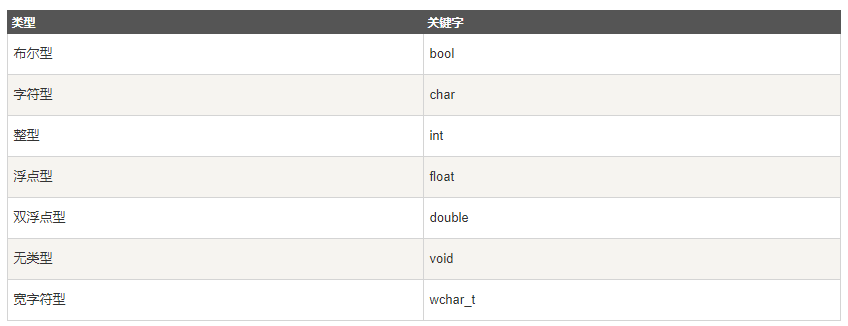目录
一.基本数据类型

一些基本类型可以使用一个或多个类型修饰符进行修饰:
signed
unsigned
short
long

需要多用才能记住。
c++的平台相关性数据类型的区别上就可见一斑,java不会有下面的问题。
windows:

centos 7.6

以上程序的代码如下:
#include<iostream>
#include <limits>
using namespace std;
int main()
{
cout << "type: \t\t" << "************size**************" << endl;
cout << "bool: \t\t" << "所占字节数:" << sizeof(bool);
cout << "\t最大值:" << (numeric_limits<bool>::max)();
cout << "\t\t最小值:" << (numeric_limits<bool>::min)() << endl;
cout << "char: \t\t" << "所占字节数:" << sizeof(char);
cout << "\t最大值:" << (numeric_limits<char>::max)();
cout << "\t\t最小值:" << (numeric_limits<char>::min)() << endl;
cout << "signed char: \t" << "所占字节数:" << sizeof(signed char);
cout << "\t最大值:" << (numeric_limits<signed char>::max)();
cout << "\t\t最小值:" << (numeric_limits<signed char>::min)() << endl;
cout << "unsigned char: \t" << "所占字节数:" << sizeof(unsigned char);
cout << "\t最大值:" << (numeric_limits<unsigned char>::max)();
cout << "\t\t最小值:" << (numeric_limits<unsigned char>::min)() << endl;
cout << "wchar_t: \t" << "所占字节数:" << sizeof(wchar_t);
cout << "\t最大值:" << (numeric_limits<wchar_t>::max)();
cout << "\t\t最小值:" << (numeric_limits<wchar_t>::min)() << endl;
cout << "short: \t\t" << "所占字节数:" << sizeof(short);
cout << "\t最大值:" << (numeric_limits<short>::max)();
cout << "\t\t最小值:" << (numeric_limits<short>::min)() << endl;
cout << "int: \t\t" << "所占字节数:" << sizeof(int);
cout << "\t最大值:" << (numeric_limits<int>::max)();
cout << "\t最小值:" << (numeric_limits<int>::min)() << endl;
cout << "unsigned: \t" << "所占字节数:" << sizeof(unsigned);
cout << "\t最大值:" << (numeric_limits<unsigned>::max)();
cout << "\t最小值:" << (numeric_limits<unsigned>::min)() << endl;
cout << "long: \t\t" << "所占字节数:" << sizeof(long);
cout << "\t最大值:" << (numeric_limits<long>::max)();
cout << "\t最小值:" << (numeric_limits<long>::min)() << endl;
cout << "unsigned long: \t" << "所占字节数:" << sizeof(unsigned long);
cout << "\t最大值:" << (numeric_limits<unsigned long>::max)();
cout << "\t最小值:" << (numeric_limits<unsigned long>::min)() << endl;
cout << "double: \t" << "所占字节数:" << sizeof(double);
cout << "\t最大值:" << (numeric_limits<double>::max)();
cout << "\t最小值:" << (numeric_limits<double>::min)() << endl;
cout << "long double: \t" << "所占字节数:" << sizeof(long double);
cout << "\t最大值:" << (numeric_limits<long double>::max)();
cout << "\t最小值:" << (numeric_limits<long double>::min)() << endl;
cout << "float: \t\t" << "所占字节数:" << sizeof(float);
cout << "\t最大值:" << (numeric_limits<float>::max)();
cout << "\t最小值:" << (numeric_limits<float>::min)() << endl;
cout << "size_t: \t" << "所占字节数:" << sizeof(size_t);
cout << "\t最大值:" << (numeric_limits<size_t>::max)();
cout << "\t最小值:" << (numeric_limits<size_t>::min)() << endl;
cout << "string: \t" << "所占字节数:" << sizeof(string) << endl;
cout << "type: \t\t" << "************size**************" << endl;
return 0;
}
二.自定义类型
typedef可以为一个已有的类型取一个新的名字。
// 语法: typedef type newname;
typedef int age_int;
age_int age;
三.枚举类型
enum 枚举名{
标识符[=整型常数],
标识符[=整型常数],
...
标识符[=整型常数]
} 枚举变量;
例如
enum color{ red ,blue,green } c;
c=blue;
四.数字声明
4.1整数常量的一些写法(八进制,十进制,十六进制)
整数常量可以是十进制、八进制或十六进制的常量。前缀指定基数:0x 或 0X 表示十六进制,0 表示八进制,不带前缀则默认表示十进制。
整数常量也可以带一个后缀,后缀是 U 和 L 的组合,U 表示无符号整数(unsigned),L 表示长整数(long)。后缀可以是大写,也可以是小写,U 和 L 的顺序任意。
85 // 十进制
0213 // 八进制
0x4b // 十六进制
30 // 整数
30u // 无符号整数
30l // 长整数
30ul // 无符号长整数
4.2浮点数常量
浮点常量由整数部分、小数点、小数部分和指数部分组成。您可以使用小数形式或者指数形式来表示浮点常量。
当使用小数形式表示时,必须包含整数部分、小数部分,或同时包含两者。当使用指数形式表示时, 必须包含小数点、指数,或同时包含两者。带符号的指数是用 e 或 E 引入的。
五.字符串声明
字符常量是括在单引号中。如果常量以 L(仅当大写时)开头,则表示它是一个宽字符常量(例如 L'x'),此时它必须存储在 wchar_t 类型的变量中。否则,它就是一个窄字符常量(例如 'x'),此时它可以存储在 char 类型的简单变量中。
写Windows程序的话,就只有L字符串是有用的,因为API都接受wchar_t*。VC++和非Windows版本的clang++分别默认L""字符串的编码为UTF-16和UTF-32。旧版本的API接受""字符串,但是在内部也是帮你转L""的,性能大打折扣。
其余的情况下,为了保证字符串的编码不会给你造成惊喜,一般都用u8""字符串来保证他是UTF-8的。
关于 \xhh,书中写得比较含糊,这是说明转义字符的格式,以\x开头,后面接两个十六进制数,h在这里应该是hex(十六进制)的意思。
char c2 = '\110'; //后面接一个三位的八进制数
char c3 = '\x0d'; //后面接一个两位的十六进制数
六.定义常量
6.1 #define
#define LENGTH 10
#define WIDTH 5
#define NEWLINE '\n'
6.2 const
const int LENGTH = 10;
const int WIDTH = 5;
const char NEWLINE = '\n';
七.const,volatile,restrict限定符

volatile 指出 i 是随时可能发生变化的,每次使用它的时候必须从 i的地址中读取,因而编译器生成的汇编代码会重新从i的地址读取数据放在 b 中。而优化做法是,由于编译器发现两次从 i读数据的代码之间的代码没有对 i 进行过操作,它会自动把上次读的数据放在 b 中。而不是重新从 i 里面读。这样以来,如果 i是一个寄存器变量或者表示一个端口数据就容易出错,所以说 volatile 可以保证对特殊地址的稳定访问。
参考资料:https://www.cnblogs.com/yc_sunniwell/archive/2010/07/14/1777432.html
restrict 是C99标准,在c++中没用。
参考资料:https://www.seotest.cn/jishu/35550.html






















 4786
4786











 被折叠的 条评论
为什么被折叠?
被折叠的 条评论
为什么被折叠?








